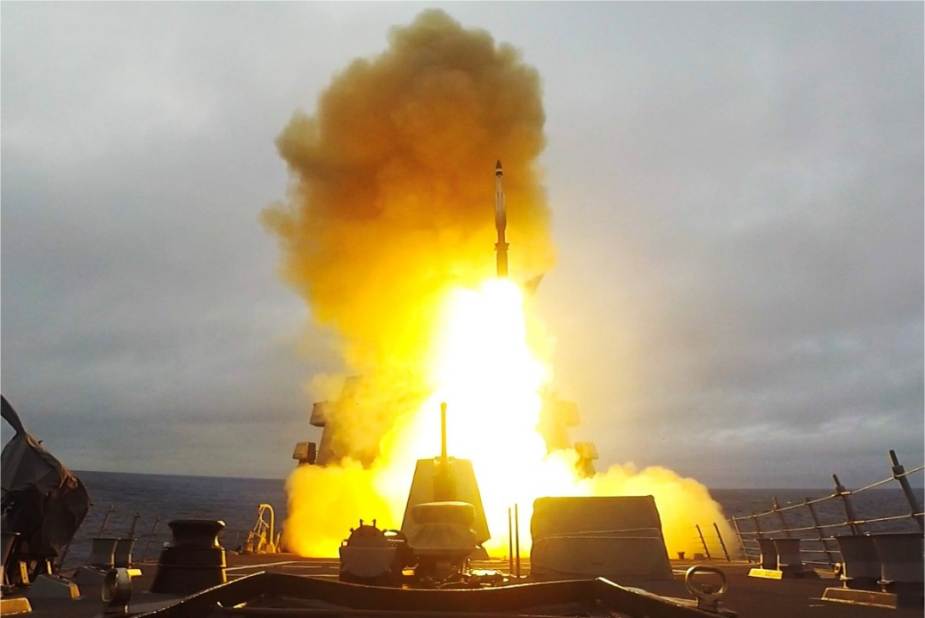Breaking news
US Navy USS Paul Ignatius guided missile destroyer successfully intercepts ballistic targets with SM-3 missiles.
According to information published by NATO on June 1, 2021, the U.S. Navy USS Paul Ignatius (DDG 117) guided missile destroyer has successfully intercept ballistic targets firing two Standard Missile-3 (SM-3) during the International Naval Exercise At-Sea-Demo/Formidable Shield 2021.
Follow Navy Recognition on Google News at this link
 - The Arleigh Burke-class guided-missile destroyer USS Paul Ignatius (DDG 117) successfully fired a Standard Missile-3 (SM-3) interceptor to engage a ballistic missile target during exercise At-Sea Demo/Formidable Shield, May 26, 2021. (U.S. Navy photo by Mass Communication Specialist 2nd Class Nathan T. Beard/Released)
- The Arleigh Burke-class guided-missile destroyer USS Paul Ignatius (DDG 117) successfully fired a Standard Missile-3 (SM-3) interceptor to engage a ballistic missile target during exercise At-Sea Demo/Formidable Shield, May 26, 2021. (U.S. Navy photo by Mass Communication Specialist 2nd Class Nathan T. Beard/Released)
The ability to launch, track and intercept missiles is key to improved defensive capability, capacity and ultimately deterrence against an ever-advancing missile threat. Ballistic missile launches are not only complex to track but require precision engineering to consummate engagements. The intercepts are kinetic, effectively hitting a bullet with a bullet at hypersonic speed in space. Maintaining the capability within the Alliance requires being able to track and share fire control quality data across multiple partners, domains, and data networks.
The At-Sea Demonstration within At-Sea Demo/Formidable Shield 21 originates from the partnership with the Maritime Theater Missile Defence Forum (MTMD-F). MTMD-F activities are important enablers of NATO Ballistic Missile Defence. The Forum is a global partnership focused on coalition capability and interoperability for Maritime Integrated Air and Missile Defence.
Bringing together ships, aircraft, ground assets and deployed staff from ten nations, including Belgium, Denmark, France, Germany, Italy, the Netherlands, Norway, Spain, the United Kingdom, and the United States, allows participants to learn from each other and strengthen relationships with Allies and Partners in the region.
The USS Paul Ignatius (DDG 117) is a Flight IIA Arleigh Burke-class guided missile destroyer in service with the United States Navy. She was launched in November 2016 and commissioned in July 2019. The U.S. Navy began procuring Arleigh Burke (DDG-51) class destroyers, also known as Aegis destroyers, in FY 1985 (FY for Fiscal Year), and a total of 87 have been procured through FY 2021, including 2 in 2021. Guided-missile destroyers are multi-mission surface combatants capable of conducting Anti-Air Warfare (AAW), Anti-Submarine Warfare (ASW), and Anti-Surface Warfare (ASuW).
The "Flight IIA Arleigh Burke" ships have several new features, beginning with USS Oscar Austin (DDG-79). Among the changes is the addition of two hangars for antisubmarine warfare (ASW) helicopters, and a new, longer 5-inch/62-caliber (127 mm) Mark 45 Mod 4 naval gun (installed onto USS Winston S. Churchill (DDG-81) and later ships). Later Flight IIA ships starting with USS Mustin (DDG-89) have a modified funnel design that buries the funnels within the superstructure as a signature-reduction measure.
The USS Paul Ignatius is armed with 1 × 32 cell, 1 × 64 cell Mk 41 vertical launch systems, 96 × RIM-66 SM-2/SM-3 surface-to-air missile, BGM-109 Tomahawk cruise missileor RUM-139 VL-Asroc anti-submarine missile, one 5 in (130 mm)/62 naval gun, two 25 mm Mk 38 automatic cannons, four .50 cal (12.7 mm) machine guns, two Mk 46 triple torpedo tubes and one 20mm Phalanx CIWS (Close-In Weapon System)
The RIM-161 Standard Missile 3 (SM-3) is a ship-based surface-to-air missile system used by the United States Navy to intercept short- and intermediate-range ballistic missiles as a part of Aegis Ballistic Missile Defense System. The latest version of the SM-3 has an operational range from 900 to 1,200 km.


























